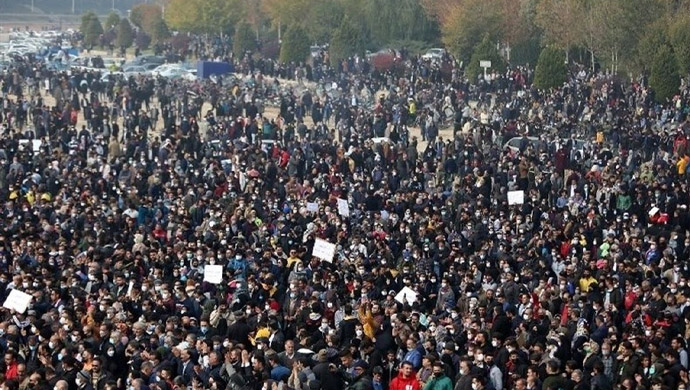Iran’s regime is promoting the State Security Forces (SSF) to the level of the Revolutionary Guards (IRGC) and the army. Chief of Staff of Armed Forces Mohammad Bagheri declared the change on Thursday and regime media declared that the plan was approved and signed by supreme leader Ali Khamenei three weeks ago.
“There are high expectancies from the SSF, and in comparison to other armed forces, the SSF is expansive at all levels… and is present in all aspects of the people’s lives,” Bagheri said.
Bagheri added that the changes is expected to make the SSF “dynamic, powerful, and agile” and “more cohesive and coordinate with other branches of the armed forces.”
Why has the regime decided to make this change all of a sudden? There are two key contributing factors.
First, Iran’s society is in an explosive state, a fact that the regime’s own media and analysts are warning about. In recent years, Iran has been in constant turmoil, with sporadic and nationwide protests taking place at shorter intervals. Iran has seen two major uprisings in 2017 and 2019, a round of major protests in Fars province in 2018, and large student protests in several cities following the downing of a Ukrainian airplane in 2020. In 2021, the regime has dealt with major protests by porters in Sistan and Baluchestan province, power outage protests across the country, water shortage protests in Khuzestan province, and most recently, intense protests by the farmers of Isfahan. In all cases, the only way the regime managed to restore control was to use excessive force, opening fire on unarmed crowds, beating, arresting, and torturing protesters. During the November 2019 protests alone, the regime gunned down 1,500 protesters. Dozens more were killed in the Khuzestan and Sistan and Baluchestan protests.
But the regime has not been able to put down the flame of resistance and dissent across Iran. It has not addressed the country’s fundamental economic problems. As a result, most of Iran’s population are living under the line of poverty and having nothing else to lose, they assemble every day to protest and voice their grievances despite the threat of the regime’s security forces.
The most recent protests in Isfahan were indicative of the state of outrage across Iran. In this regard, the Etemad newspaper warned on November 27, “What happened in Isfahan was the fire under ashes that sprang to life.” The Isfahan uprising was a serious warning for the regime. Despite the heavy presence of security forces, anti-riot units, IRGC motorcades, and intelligence officers, the people poured into the Zayandeh Rud basin and other parts of the city, held protest rallies, resisted the repressive forces, and chanted anti-regime slogans.
Given the current circumstances, the regime hopes that by bolstering its State Security Forces, it will be able to better respond to the protests that are sparking across the country.
A second important factor is the low morale of the regime’s troops.
Khamenei has on several occasions warned about the low morale of commanders and rank-and-file soldiers in different speeches and tried to rally his troops by blaming the country’s problems on “foreign enemies.” But as has been seen in consecutive rounds of protests, the regime’s apparatus of suppression is losing its efficiency in face of the growing outrage and determination of the people.
By promoting the suppressive SSF, the regime hopes to give its troops and commanders a boost of morale and provide them with incentives to stay on the losing side.
This is a path that the Shah, the mullahs’ predecessor, tried before the overthrow of his regime in 1979. The Shah appointed one of his top generals as his prime minister and changed the structure of the executive branch into that of a military body. But a few months later, the Shah regime, with all its military might, crumbled before the will of a nation that had willed to overthrow the tyranny ruling their country.
Now 43 years later, the mullahs are going down the same path, hoping for a different outcome.





